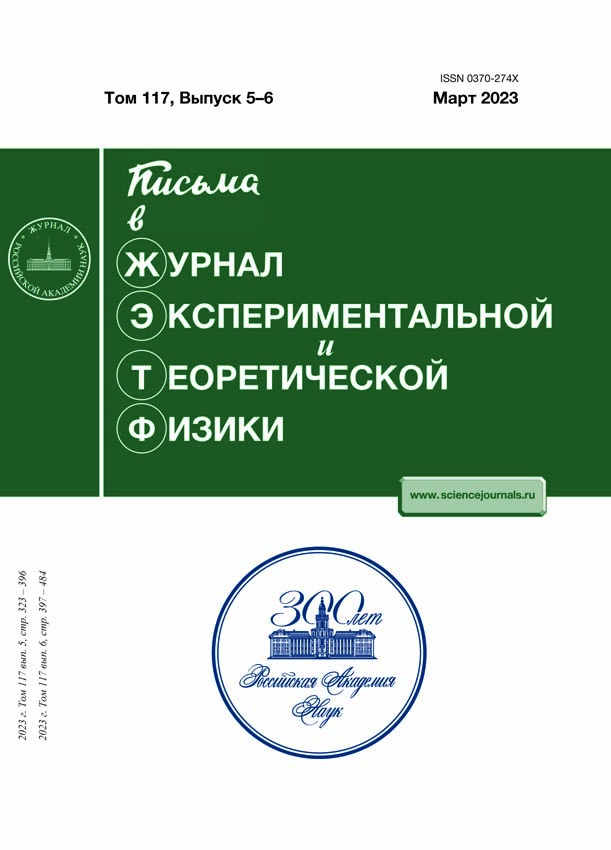Specific Features of Landau Level Mixing and the Electron Distribution Function under Conditions of the Quantum Hall Effect
- 作者: Van'kov A.B1,2
-
隶属关系:
- Institute of Solid State Physics, Russian Academy of Sciences
- National Research University Higher School of Economics
- 期: 卷 117, 编号 5-6 (3) (2023)
- 页面: 356-362
- 栏目: Articles
- URL: https://rjonco.com/0370-274X/article/view/662529
- DOI: https://doi.org/10.31857/S1234567823050063
- EDN: https://elibrary.ru/PXGKMU
- ID: 662529
如何引用文章
详细
The electron distribution over Landau levels is calculated in the regime of the quantum Hall effect at strong Coulomb interaction. For this purpose, a modified scheme of exact diagonalization with a significantly reduced basis of many-particle configurations has been developed, which makes it possible to adequately take into account the mixing of states in several Landau levels. The behavior of the electron distribution function over Landau levels is studied as a function of the filling factor and the Wigner–Seitz radius rs. It is shown that the Landau quantization at a fixed electron density significantly suppresses the smearing of the electron distribution function as compared to the case of zero magnetic field. For example, for rs < 1 and low filling factors, the quasiparticle contribution to the Migdal jump 1 − Z in the distribution function is an approximately linear function of ν and a quadratic function of rs. Simultaneously, as ν decreases, the tails of the distribution function become longer. The mechanism of rearrangement of the distribution function in the regime of the quantum Hall effect is described in terms of the generation of magnetoplasmon fluctuations involved in the structure of the ground state of the system.
作者简介
A. Van'kov
Institute of Solid State Physics, Russian Academy of Sciences; National Research University Higher School of Economics
编辑信件的主要联系方式.
Email: vankov@issp.ac.ru
142432, Chernogolovka, Moscow region, Russia; 101000, Moscow, Russia
参考
- Л. Д. Ландау, ЖЭТФ 30, 1058 (1956).
- Л. Д. Ландау, ЖЭТФ 32, 59 (1957).
- А. Б. Мигдал, ЖЭТФ 32, 399 (1957).
- В. П. Силин, ЖЭТФ 34, 781 (1958).
- M. S. Hossain, M. K. Ma, K. A. Villegas Rosales, Y. J. Chung, L. N. Pfei er, K. W. West, K. W. Baldwin, and M. Shayegan, PNAS 117(51), 32244 (2020).
- J. Falson, I. Sodemann, B. Skinner, D. Tabrea, Y. Kozuka, A. Tsukazaki, M. Kawasaki, K. von Klitzing, and J. H. Smet, doi: 10.1038/s41563-021-01166-1.
- V. V. Solovyev and I. V. Kukushkin, Phys. Rev. B 96, 115131 (2017).
- И. В. Кукушкин, ЖЭТФ 162(10), 480 (2022).
- А. Б. Ваньков, И. В. Кукушкин, Письма в ЖЭТФ, 113(2), 112 (2021).
- C. Kallin and B. I. Halperin, Phys. Rev. B 30, 5655 (1984).
- В. Е. Бисти, А. Б. Ваньков, А. С. Журавлев, Л. В. Кулик, УФН 185(4), 337 (2015).
- V. M. Galitski and S. Das Sarma, Phys. Rev. B 70, 035111 (2004).
- G. Burkard, D. Loss, and E. V. Sukhorukov, Phys. Rev. B 61, R16303 (2000).
- N. D. Drummond and R. J. Needs, Phys. Rev. B 79, 085414 (2009).
- Yu. A. Bychkov and A. V. Kolesnikov, ZhETF 107, 1933 (1995).
- F. D. M. Haldane, Phys. Rev. Lett. 55, 2095 (1985).
- A. P. Smith, A. H. MacDonald, and G. Gumbs, Phys. Rev. B 45, 8829 (1992).
- A. H. MacDonald, J. Phys. C: Solid State Phys. 18, 1003 (1985).
- С. М. Дикман, В. М. Жилин, Д. В. Кулаковский, ЖЭТФ 128(11), 1025 (2005).
补充文件









